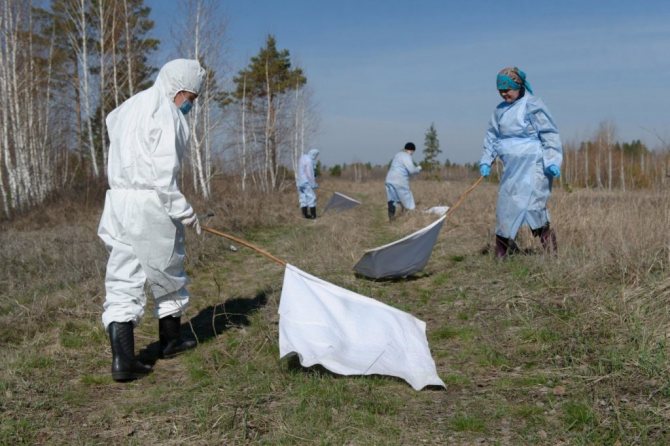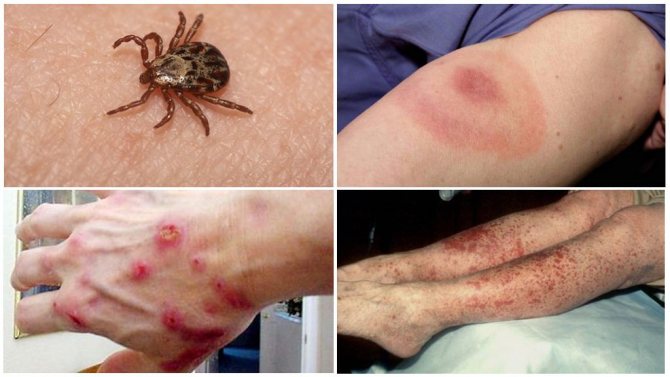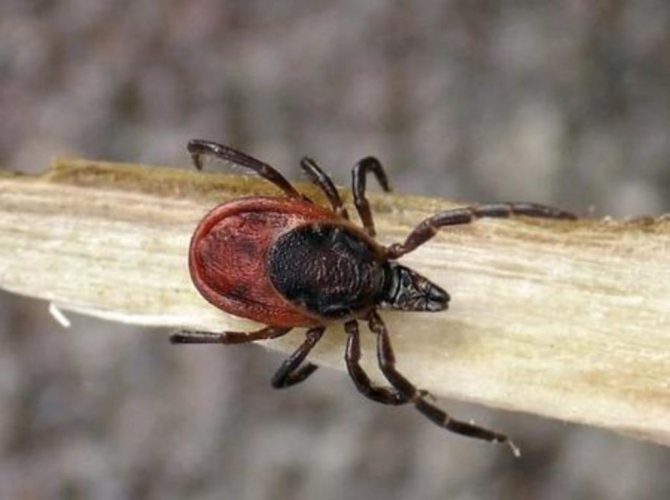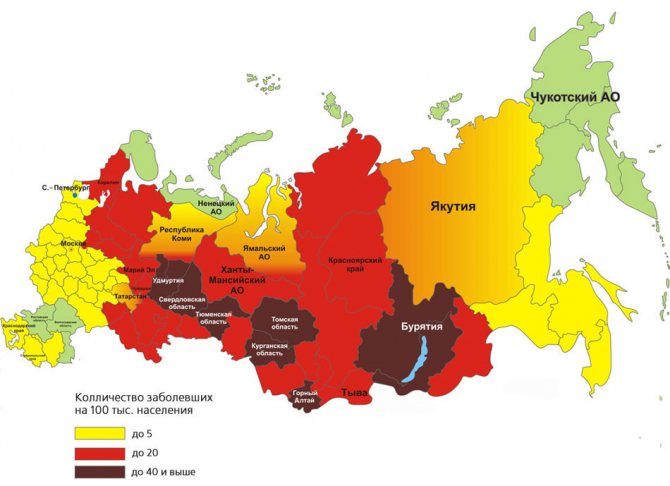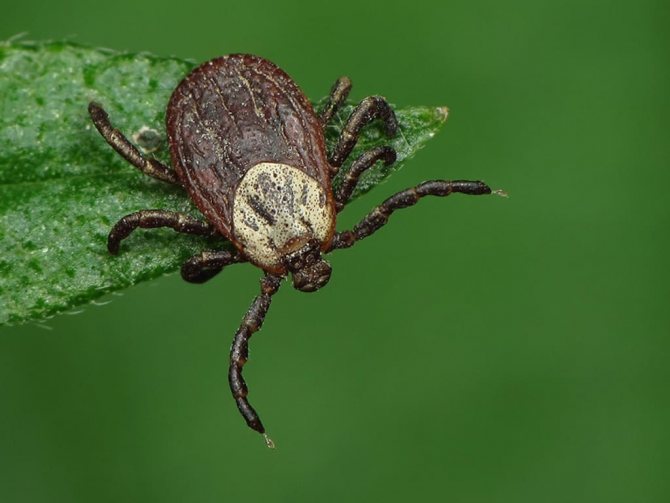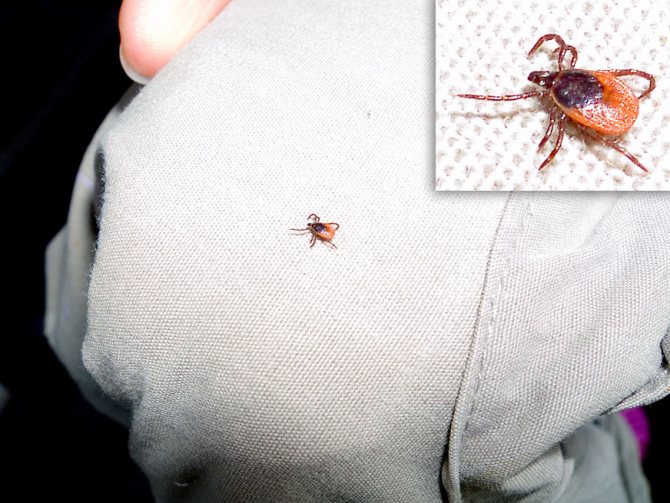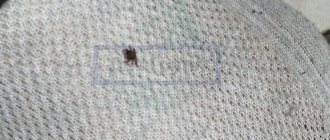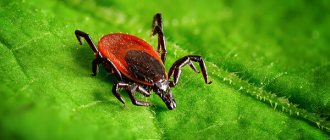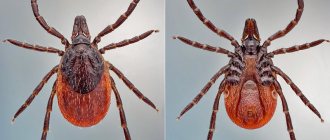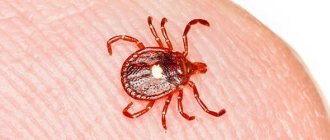Tick-borne encephalitis is a dangerous disease that can be contracted during the most seemingly serene period - spring and summer. Children have holidays, the weather seems to be calling to go to nature in order to throw off the hustle and bustle of the days gone by. But we must not forget that, leaving civilization, you can catch a bunch of dangerous diseases that can turn out to be very, very sad. Encephalitis is one such disease.
Ixodid tick species: what forests do they live in?
Where do ixodid ticks live?
Most often, ixodid ticks are found in thickened areas of the forest overgrown with shrubs, where the sun's rays do not fall. They are especially fond of neglected forest clearings left in disarray by "black" lumberjacks.
The danger of a tick attack begins with the onset of freezing temperatures, when the first thawed patches begin to appear, and continues until the end of September. In July, their activity decreases slightly.
Forest ticks are small in size, reaching a length of 2-5 mm in a hungry state. Such arachnids belong to the subclass of arthropods and live almost all over the world, except for Antarctica. The variety of parasite species differs in the place of life and the nature of the diet.

There are other types of such parasites:
- gamasid mites, red beetles and argas mites, which are also capable of consuming human and mammalian blood;
- dust mites (saprophytes), whose life takes place in living quarters with people, prefer to feed on dead particles of the epidermis;
- subcutaneous (demodexes) - live in the upper layer of the human epidermis and at the base of the hair follicles, they are of the smallest size, so they can only be seen under a microscope.
Optimal living conditions for ticks:
- regions with high humidity, at least 80%;
- sun-warmed slopes with dense grass and shrubs up to 1 m high;
- the main habitat of ticks: forest edges, glades, ravines with dense grass;
- fern thickets in the shade of deciduous trees, among low young trees (aspen, hazel, etc.);
- most often parasites live in coastal thickets near rivers, ponds, lakes and streams, where forest animals come to drink;
- soil surface with fallen leaves or grass cuttings.
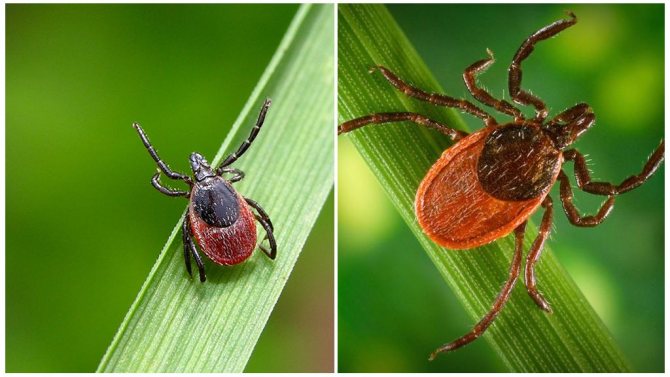

Mites in nature
The most unsuitable habitats for ticks: hills, areas without grass and plants, dry undergrowth in a pine forest, etc.
Among the family of ixodid parasites, there are some species that choose different habitats:
- Meadow ticks of the genus Dermacentor are carriers of many viral infections that can infect humans and even pets (piroplasmosis in dogs). Distributed in the zones of deciduous and mixed forests of Europe and Siberia, prefer clearings, forest edges, meadows and pastures, flooded meadows.
- The genus Hyalomma and its representatives prefer to settle in the steppe zone, live in the southern regions of Russia, Crimea, Bulgaria and the Mediterranean coast, in Asian countries. They can spread hemorrhagic fever.
- Birch mites belonging to the Haemaphysalis family are moisture- and heat-loving parasites, their habitat: Crimea, Transcaucasia and the Far East, Altai, southern part of Western Siberia and Transbaikalia. They settle in birch-deciduous, coniferous-deciduous, in aspen and birch forests.They can be carriers of encephalitis and rickett disease.
- The brown dog tick of the genus Rhipicephalus prefers coastal areas with high humidity: the Black Sea coast. The object of his attack is often dogs, but the spread of dog ticks occurs very quickly due to their ability to reproduce in a human dwelling or a dog kennel, where they can establish entire colonies. Carriers of the Marseilles fever.
Symptoms of the disease


Symptoms of European encephalitis in the first stage of the disease
The irritation at the site of the bite quickly passes, and the person forgets about the incident. But after 1-2 weeks he feels unwell and in no way connects this with the arthropod that bit him.
In the first stage, it is very difficult to distinguish between encephalitis infection and other diseases, of which there are a good dozen. And not all of them are contagious.
The main symptoms of European encephalitis in the first stage, lasting 2-4 days:
- muscle pain;
- lack of appetite;
- headache;
- fever;
- nausea, possibly with vomiting;
- general malaise.
At this stage, encephalitis is easy to confuse even with a common flu and try to self-medicate. After 8 days (the period of complete recovery from the flu), remission occurs. The patient sincerely believes that it was the flu and forgets about the illness. If you're lucky, there will be no consequences of encephalitis.
But in 20-30% of those infected, after remission, the second stage of the disease follows with damage to the central nervous system:
- meningitis: severe headaches, tight neck muscles (similar to myositis), fever;
- encephalitis: impaired coordination of movements up to paralysis, sensory disorder, impaired consciousness;
- a mixed form that will "please" with the simultaneous signs of encephalitis and meningitis.
Far Eastern encephalitis develops more rapidly. It begins with a sudden rise in body temperature to 38-39 ° C. Severe headache and nausea appear. Sleep is disturbed. There is no remission stage. After 3-5 days, damage to the central nervous system develops.
It doesn't matter what color the tick has managed to dig into the body. In terms of transmission, there is no difference between the two.
Moreover, any blood-sucking organism parasitizing mammals can be dangerous in an infected area. To prevent infection, you must observe safety measures and take care of a vaccination against encephalitis in advance.
What will happen in case of complications


Complications of this viral disease are very serious and often the course of the disease, if you do not go to the doctor in time, will not depend on the patient in any way. So, in order to avoid complications, it is very important to carry out early diagnosis of the disease.
As a rule, complications in children are the most deplorable: According to statistics, 10% die within the first 7 days. Survivors may be left with lesions of the nervous system in the form of muscle twitching, paresis of the arms and legs, shoulder atrophy, or become carriers of the virus.
In adults, if there was a meningeal and febrile form, complications are minimized. After completing the necessary course of treatment, the patient fully recovers. In other forms, disorders of the nervous system remain. There may be complete and incomplete paralysis of the muscles of the neck and shoulder girdle, mental disorders, memory problems, stupidity (stupor), clouding of consciousness, Kozhevnikov's epilepsy. With a high degree of severity, the consequences can be fatal.
In animals, the consequences of complications are also deplorable: the lesion is transferred to the entire central nervous system, while the pets do not recover. Their immune system also suffers. Dogs that have been bitten by an infected tick are advised by veterinarians to be euthanized for humane purposes.
How is the process of feeding ticks carried out and how does human infection occur?
- The sucked tick begins to secrete saliva into the resulting wound. The salivary glands of the mites are huge, occupying almost the entire body in length.Saliva has a variety of functions. The first portion of saliva hardens in the air and forms the so-called "cement secretion" that firmly adheres the proboscis to the skin.
- Subsequently, liquid saliva contains a lot of various biologically active substances. Some of them numb the wound, others destroy the walls of blood vessels and surrounding tissues, while others suppress the host's immune responses aimed at rejecting the parasite.
- Blood and particles of destroyed tissue entering the wound are diluted with saliva and absorbed by the tick.
How and why does infection occur?
tick card
Paradoxical as it may sound, the danger of contracting tick-borne encephalitis is an integral and natural property of our forests. The most important role in maintaining natural foci of infection belongs to small forest animals - voles, mice, shrews, squirrels and chipmunks. The animals themselves are susceptible to infection, the virus multiplies well in their body, but the disease proceeds without visible harmful consequences. In addition, the virus also multiplies in the body of the carrier - the tick.
In tick-borne encephalitis virus infected ticks, the pathogen is capable of multiplying in many tissues and organs and very often it is present in the salivary glands. The mite, which has sucked onto the body of the host (including humans), begins to secrete saliva into the resulting wound. The first portion of saliva hardens in the air and forms the so-called "cement secretion" that firmly adheres the proboscis to the skin. Together with this saliva, the virus enters the body of an animal or a person, and if the dose of the virus is large enough, then a disease can develop. Studies have shown that the above-mentioned "cement secretion" can contain up to half of the total amount of the virus contained in the tick. Therefore, even if you remove the tick almost immediately after it sucks, you can still get infected, in this case the source of infection will be the "cement" remaining in the skin. It has also been proven that the infection is transmitted by male bites. A short-term and painless male bite may not be noticed, especially when the forest is full of mosquitoes and midges. Most likely, quite common cases of tick-borne encephalitis, when patients deny a tick bite, are associated precisely with the attack of males.
Where do virus-infected ticks come from in nature? The fact is that natural foci of tick-borne encephalitis existed long before the appearance of man in Siberia. It is not known for sure whether the virus was originally associated only with ticks or only with vertebrates. However, in the process of evolution, the virus has adapted to exist in organisms of both those and others. Although the virus actively multiplies in wild forest animals, they do not exhibit pathological disorders characteristic of human disease.
At the same time, those animals that do not encounter this pathogen in their natural environment (for example, house mice or some monkeys that are used as experimental animals in virological studies) get sick in exactly the same way as humans.
So, infected wild forest animals, in which the virus is present in the bloodstream, serve as a source of infection for ticks feeding on them. Having entered the intestines of the parasite with blood, the pathogen penetrates into various organs and tissues, including the salivary glands, and begins to multiply there. When mites molt to the next phase of development, the pathogen remains. With the next bloodsucking, the virus can enter the body of an uninfected animal and the whole chain of events repeats over and over again, ensuring a constant exchange of pathogens between ticks and their hosts.
Adult ticks are dangerous to humans.
What should I do if bitten by a tick?


If you find a sucked parasite on your body, you first need to go to the hospital. The sooner you do this, the less likely you are to get sick with tick-borne encephalitis.If it is not possible to consult a doctor immediately after the bite, then you need to remove the stuck bloodsucker yourself.
It is strictly forbidden to squeeze out the tick, since when it ruptures, the infection will quickly enter the bloodstream, and the disease in this case cannot be avoided. There are several ways to extract the parasite. The most effective is to take the thread and tie a knot as close to the bloodsucker's proboscis as possible, then slowly pull the tick up with rotational movements. You cannot do this abruptly, as the head may come off and remain under the skin. If this happens, it is necessary to treat the bite site with alcohol and remove the head like a splinter with a sterile needle.
After the tick has been removed, the wound must be treated with alcohol or iodine. And put the parasite in a jar and take it to the laboratory for microscopic diagnostics. Important: it must be delivered to its destination alive so that specialists can examine it.
What does the tick eat?
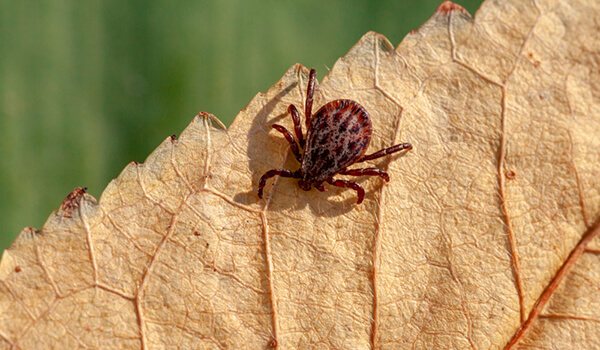

Photo: Tick in the forest
Ticks also differ in the way they feed.
On this basis, they can be divided into two groups:
- saprophages;
- predators.
Saprophages consume organic residues. That is why such mites are recognized as very useful for nature and humanity, since they make a certain contribution to the creation of humus. However, there are saprophagous mites that feed on plant sap. These are parasitic mites. This type of animal causes great harm to agriculture, since it can destroy the harvest of grain crops.
There are mites that eat exfoliated particles of human skin - the epidermis. These mites are called dust mites or scabies. Barn mites are suitable for feeding on plant residues that decompose, incl. rotting flour and grain.
For a subcutaneous mite, the ideal option is subcutaneous fat, which it takes in human hair follicles, and for an ear mite, the fat of the ear canals. Predatory ticks parasitize other animals and plants. With the help of its legs, the blood-sucking mite attaches itself to its prey, and then purposefully moves to the place of feeding.
Origin of the species and description


Photo: Tick
Tick refers to arachnids that feed on the blood of animals and humans. Nowadays, there are a huge number of varieties of this species, up to 40 thousand.
But two types play a significant epidemiological role:
- taiga tick - its habitat is the Asian and partly European part of the continents;
- European forest tick - habitat is the European mainland of the planet.
Video: Tick
To this day, scientists have not come to a consensus about exactly where the ticks came from and from whom they came. The main thing is that for a million years of evolution, they practically did not change. The fossil mite is very similar to the modern primitive individual.
The main hypotheses for the origin of ticks today are as follows:
- neotenic origin. Ticks could come from chelicerae animals, which were several times larger, but were at an early stage of their development;
- origin from floating larvae of creatures that were deprived of the ability to move, and did not have a central nerve rod;
- occurred by truncating the life cycle of an animal, which was more specialized.
The latter hypothesis has even been directly confirmed. So, a cheliceral animal was found with a clutch of hatched eggs. The larvae of these eggs are very similar to ticks, incl. have the same number of legs.
Encephalitis tick: life in pictures


Fig. 3. Photo of an encephalitis tick. Male (left) and female (right). They have a powerful carapace and four pairs of legs.


Fig. 4 The female encephalitis tick lays eggs in the months of May and June after being engorged with blood. Of the 1.5-2.5 thousand laid eggs, only a few individuals survive to adulthood.
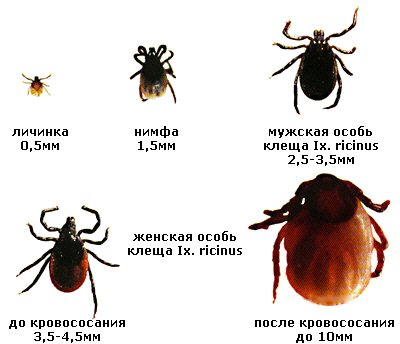

Fig. five.From the eggs laid by the female, after a few weeks, larvae appear the size of a poppy seed with a third pair of limbs. Small animals and birds are their prey. Having sucked blood after 3 - 4 days, they leave the "breadwinners". In the forest litter, they molt and they turn into nymphs. Nymphs reach 1.5 cm in length and already have four pairs of limbs. After spending the winter, the nymphs choose larger “breadwinners” for themselves. After a year, each nymph turns into either a female or a male. Almost all species of forest animals, livestock, and many species of birds that feed on the ground are the places where encephalitis ticks are parasitized.
During the entire development cycle, which is 3 - 5 years, ticks feed three times. Of all the eggs laid by the female, dozens of individuals survive, which pose a threat to humans.
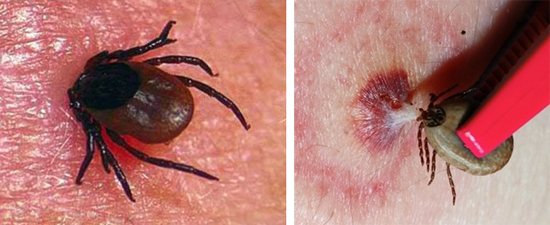

Fig. 6. Bite of an encephalitis tick. Ticks have huge salivary glands that occupy the length of the entire body. At the first moment of the bite, the secreted saliva firmly adheres the proboscis to the skin. The liquid part of saliva numbes the wound, destroys the vascular wall and suppresses the host's immune response.
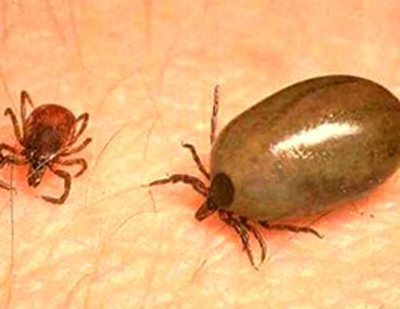

Fig. 7. Female encephalitis tick before and after blood suction.
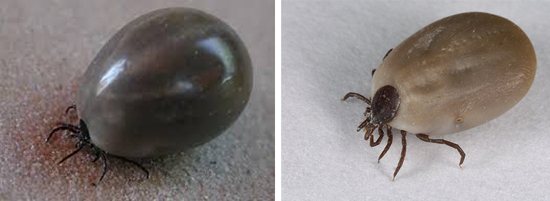

Fig. 8. Encephalitis tick after being bitten (in the photo the female was sucking blood). The ability to stretch the back of the body allows females to suck blood hundreds of times greater than a hungry individual. Females stick on for 5 - 6 days. Males suck only for an hour. The rest of the time they spend in search of a female for mating.
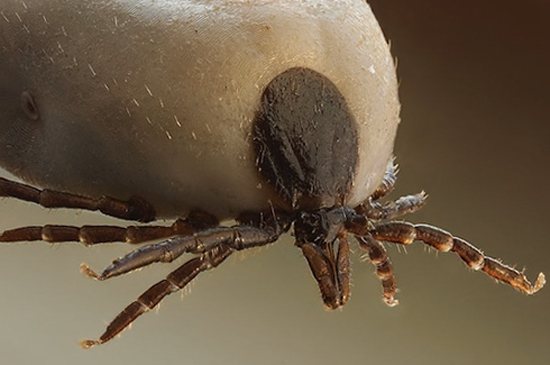

Fig. 9. In the photo there is a female encephalitis tick. Ticks do not have eyes, but their sense of smell is very keen. They are able to catch the smell of animals and humans being up to 10 meters away from them.


Fig. 10. In the photo, the tick in the active waiting position - the front legs are extended and make movements from side to side. When the "breadwinner" approaches, the tick's reaction is instantaneous. Their paws, equipped with suction cups, allow them to firmly hook on the victim.


Fig. 11. Encephalitis ticks on humans. Most often, the tick rises through the clothes from the bottom up and only then it is found on the neck, head and shoulders. Ticks are very mobile!
Tick-borne encephalitis is recorded strictly in the spring-summer period, which is associated with their maximum activity during this period.
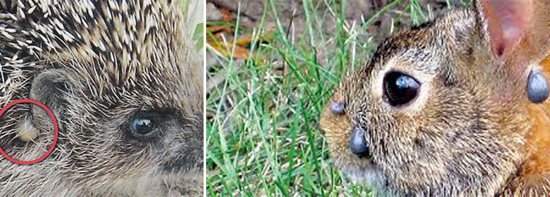

Fig. 12. Encephalitis mites on animals.
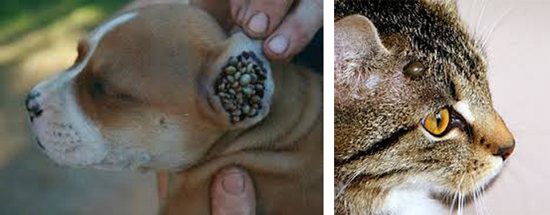

Fig. 13. Encephalitis mites on animals.
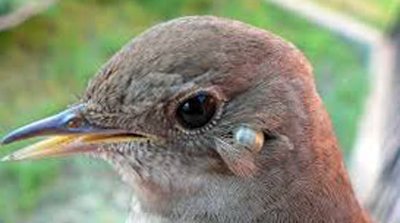

Fig. 14. Encephalitis mites on birds.
Intestinal epithelial cells and tick salivary glands are the main breeding sites for tick-borne encephalitis viruses. Here they persist for many years and are released outward during the laying of eggs and are transmitted to some species of animals and birds during bloodsucking, where they multiply and are transmitted to new ticks. Parasitizing the bodies of animals and birds, ticks infected with viruses are carried over great distances.
What methods of prevention and precautions exist for people
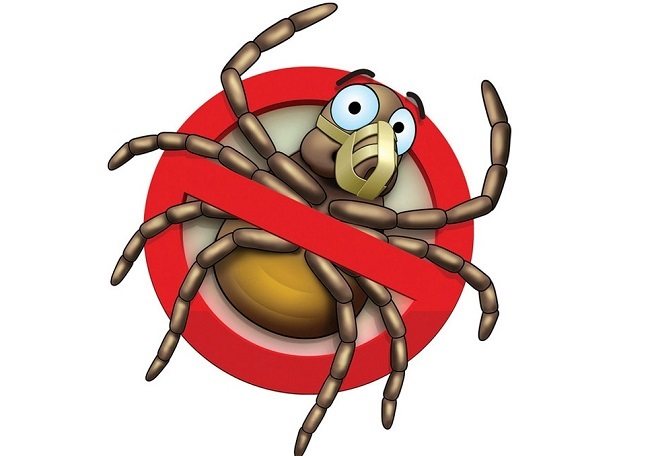

Prevention of tick-borne encephalitis is especially important in areas where the arachnid is found in large numbers. Vaccination is the most effective precautionary measure. For adults, it can be carried out according to the standard scheme in 3 injections or according to the accelerated scheme in 2.
The standard procedure is carried out in the fall, then in the winter and then another year later. Re-vaccination is then required only after 2 years. And so every 2 years a repeat of the vaccine.
The accelerated vaccination schedule involves the introduction of the vaccine in the spring, during the activation of ticks. The next prophylactic injection will be after 2 weeks. During this period, it is advised to limit, if possible, any contact with insects.
Contraindications for vaccination are:
- Chronic diseases in the stage of relapse (diabetes mellitus, hypertension 2 and 3 degrees, etc.);
- Allergic reactions during a relapsing period;
- Pregnancy;
- Infectious diseases;
- Acute reaction of the body, felt by the body earlier and individual intolerance to the vaccine.
Childhood prophylaxis follows the same principle as in adults. Vaccination is carried out in a medical institution from 12 months of age and with a mandatory doctor's report on the absence of contraindications.
When planning a trip to nature, you should also follow the precautions:
- Wear light-colored clothing (then the tick will be clearly visible);
- It is desirable that the fabric is sliding (so it will be more difficult for the tick to move)
- Tuck trousers into boots or tight socks;
- The shirt should be long-sleeved, close-fitting to the body, with a closed collar, it must also be tucked into the trousers;
- Hair should be tucked into a headdress;
- Use anti-bite agents (acaricides and repellents).
Natural ticks
The way of life of ticks and their biological characteristics depends on what they eat.
Ixodid ticks
There are many types of ixodid ticks. They are common both in tropical rainforests and in desert areas. They feed on the blood of vertebrates: mammals, reptiles and birds.
For humans in our latitudes, two species are the most dangerous: European forest ticks and taiga ticks.
The first is widespread in Europe (except for its northernmost part), North Africa and the European part of the Russian Federation. inhabits the middle and southern zones of the taiga.
These two types are the main distributors of such dangerous diseases as viral tick-borne encephalitis, borreliosis (Lyme disease), hemorrhagic fever. Getting sick with Lyme disease due to tick bites is most likely in the suburbs, Moscow, Krasnodar Territory. In the Rostov and Volgograd regions, in the Caucasian region of Russia, there is a risk of contracting hemorrhagic fever. The situation with the spread of viral encephalitis is no better. These are the Northwestern District of the Russian Federation, Karelia, the Volga region, many regions of the Central District, the entire Far East. Vladivostok occupies the leading positions in the easternmost part of the country.
It has been established that this species of arthropods is dangerous at almost all stages of its development. Nymphs and larvae are looking for a host after their birth. The larva waits for its prey on the ground. As a rule, these are small rodents. The nymph prefers larger animals.
Demodex, or iron
Scientists have not established exactly how this subcutaneous mite spreads among people. There is an opinion that with close contact, the general use of personal hygiene products and cosmetics, the disease passes from a sick person to a healthy one. It should be noted that outwardly, the carrier of Demodex can be absolutely healthy.
Scabies mite
It is also called itch itch. It is the cause of such an unpleasant disease as scabies. It spreads from a sick person to a healthy person after close physical contact (handshake, skin-to-skin touch, intimacy). Animals do not get human scabies, but they can carry it.
How and where you can get encephalitis


The first variant of virus infection is the most transmissible, the most primitive. For prevention, it is necessary to strictly observe safety rules, being far from civilization.
Like any parasite, the tick is introduced to the skin of a person or animal thanks to a special proboscis. This can be preceded by a long waiting time in the grass or on a bush. As a rule, a person does not feel a tick bite in any way.
If the introduction of a tick into the body was noticed, it should be immediately removed from the skin of a person or animal. For help, you can contact the nearest clinic, where special medical care will be provided, or you can do it yourself.
The virus itself is contained in the saliva of the arachnid. So even if the extraction occurred immediately, it is imperative to check for the presence of a virus. The disease can be contracted even by crushing.
In addition, there is another form of transmission of tick-borne encephalitis.The fact is that goats, sheep and cows can suffer from this disease without any consequences for themselves. Goats among them are champions, they can get encephalitis several times a year, and their condition will be stable. But their milk will contain the virus.
Having drunk such milk, you can immediately become infected. However, the virus dies when exposed to high temperatures. Therefore, the advice that any milk needs to be boiled must always be followed - and in this case it does not matter what season of the year it is, - because the virus in the body of cattle can be kept for a long time.
In addition, hygiene standards for the animals themselves are also important so that they do not get sick with encephalitis. This means that it is necessary to clear the territory, more often to clean the corrals, to fight rodents that can be the causative agents of other, no less dangerous diseases, and also to constantly examine the animals for the presence of arachnid parasites.
Encephalitis ticks live in central Russia, Ukraine, Belarus, Kazakhstan.
Every year Roskomnazor publishes data on which areas are the most unsafe. As a rule, these are Siberia, the Far East, the Urals, Buryatia, the Irkutsk Region, the Perm Territory, the Volga Region and the North-West District.
In Ukraine, this is the Transcarpathian region, almost the entire territory of Belarus, especially the zone of Belovezhskaya Pushcha and the Berezinsky reserve, and in Kazakhstan - Almaty and East Kazakh regions.
Can ticks live in the house?
It happens that after a walk, dogs or cats bring blood-sucking parasites into the house in their fur. Often the person himself unnoticed brings them into the house along with bouquets of forest flowers, berries or mushrooms. If you do not carefully examine all the clothes after returning from the forest or park, you may not notice the parasite lurking on it.
How many ticks can live in an apartment?
Ticks brought in from the street will live in the house for no more than 9 months. They reproduce only in their usual environment. In an apartment where there is no plant litter, their eggs will not develop. On a cat or dog, ticks cannot reproduce and live fully.
Nevertheless, you should carefully examine yourself and your companions after each foray into nature, so as not to introduce parasites into an apartment or a private house.
Dog tick
The Latin name of the species is Ixodes ricinus. The arthropod is widespread throughout the Eurasian continent. You can also find it in North America and North Africa. On the last two continents, there is no encephalitis virus, and there this type of tick is definitely not encephalitic. But it can reward other dangerous diseases.
The dog tick is a common arachnoid mite familiar to almost everyone. Dog breeders are more worried about the piroplasmosis carried by them than the encephalitis virus. The size of arthropods can be different depending on at what stage of development the tick decided to drink blood. Larvae and nymphs, which differ from adults only in size, begin to drink blood. A hungry nymph is 1.3-1.5 mm long. An adult male is 2.5 mm. Hungry adult female 4 mm long. After she is full, she swells to 1.1 cm.
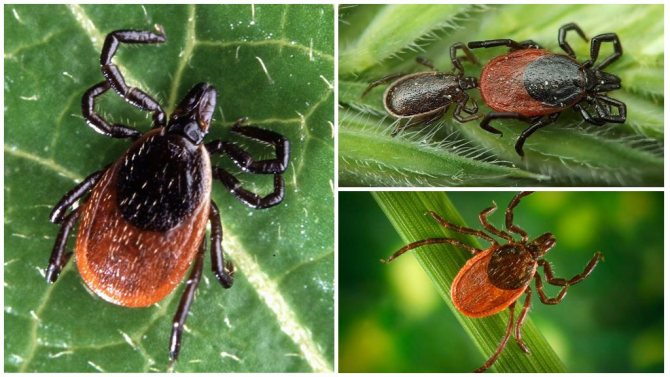

Dog tick
The body of a dog tick has the shape of an egg with a very sharp tip; there is a proboscis on its head. The back is protected by a dark brown shield. In males, the scutellum completely covers the entire body. In females, larvae and nymphs, the scutellum is much smaller and protects only the front part of the back. The abdomen of a hungry female is gray below and black above.
Where are the most mites
They are found in areas with high humidity levels, the most advantageous place is mixed and deciduous forests. In Europe, parasites are easy to find in garden plots, forest and city parks. Sometimes found in northern regions and highlands.
On the territory of Russia, forest and dog ticks are often found (you can see the distribution halo on the map above). In the forest parks of the Far East and Siberia, you can meet with the taiga parasite. The most dangerous place is Western Siberia and the Urals - more than 80% of cases of such insect bites are recorded here. In Northern and Central Europe, as well as in the European part of Russia, encephalitis canine tick is widespread.
Previously, parasite bites and subsequent complications were occupational diseases, since those whose work activities were associated with the forest were infected. It is noted that the infection of rural and urban residents occurs in the same way.
Parasites choose an area with high humidity, so they are most often found in countries whose territories are rich in glades, forest edges, low shrubs and thick grass. The taiga and forest European ticks are dangerous for human health. The latter species is often found in northern Europe, European Russia and North America. Taiga dangerous insects are common in the areas of the southern and northern taiga.
These are carriers of especially dangerous pathogens: hemorrhagic fever, Lyme disease and encephalitis. Borreliosis ticks are often found in the Krasnodar Territory, Moscow and the Moscow Region. It is possible to become infected with hemorrhagic fever in the Caucasus, in the Volgograd and Rostov regions. The encephalitis tick was seen in the Far East, the Volga region, Karelia, and the northwestern part of Russia. In the East, ticks are more common in Vladivostok.
Rarely, but still there are parasites along forest and park paths. When the temperature drops below 5 degrees, they burrow into moss or foliage. Insects are attracted by branches, rubble, garden plots and parks rich in foliage. Similar places in large cities are not bypassed either.
Tick behavior
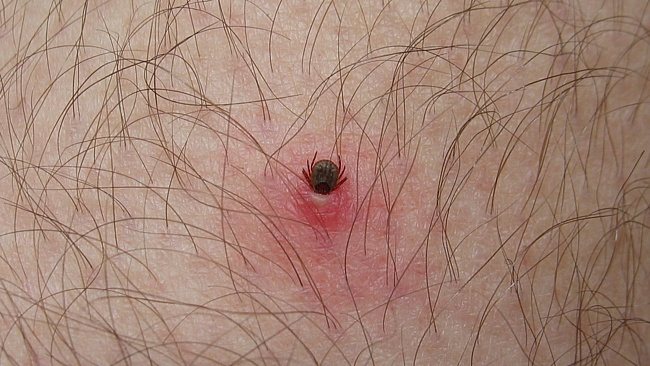

The first active adult ticks appear in early or mid-April, when the sun begins to warm up and the first thawed patches form in the forest. The number of ticks increases rapidly, reaching a maximum by the beginning of the second decade of May, and remains high until mid or late June, depending on the weather. Then it sharply decreases due to the extinction of ticks, which are depleted of reserve nutrients. However, single active parasites can be caught up to the end of September.
Ticks lie in wait for their prey, sitting at the ends of blades of grass, blades, sticks and twigs sticking up.
When a potential victim approaches, the ticks assume an active waiting posture: they stretch their front legs and move them from side to side. On the forelegs are the organs that perceive odors (Haller's organ). Thus, the mite determines the direction to the source of the smell and is made to attack the host.
Ticks are not particularly mobile; in their lifetime they are able to overcome no more than ten meters on their own. A tick waiting for its prey climbs a blade of grass or a bush to a height of no more than half a meter and patiently waits for someone to pass by. If an animal or a person follows in the immediate vicinity of the tick, then its reaction will be instant. Having spread its front legs, it frantically tries to grab its future owner. The paws are equipped with claws and suction cups, which allows the tick to securely catch on. No wonder there is a saying: "Grabbed like a tick."
With the help of hooks, which are located at the very end of the front legs, the tick clings to everything that touches it. Ixodid ticks (European forest tick and taiga tick) never attack and never fall (do not plan) on the victim from above from trees or tall bushes: ticks simply cling to their prey, which passes by and touches the blade of grass (stick) on which it sits mite.
Having settled on the animal, the tick chooses a place to feed.In most cases, this is the area of the head and neck, where the animal cannot reach with its teeth and destroy the parasite. Then he plunges his mouth parts (the so-called proboscis) into the skin and, cutting through it, gets to the subcutaneous blood vessels, from where it sucks blood. The teeth on the proboscis, directed backward, and the first portion of saliva, which quickly hardens and adheres the mouth organs to the skin, like cement, help him securely to anchor.
Females of ticks feed for about 6 days, while absorbing an incredible amount of blood, a well-fed female becomes the size of a phalanx of a little finger, her integuments acquire a dirty gray color with a metallic tint, and her weight increases more than a hundred times compared to the weight of a hungry individual.
Males suck for a short time, in order to replenish the supply of nutrients and water in the body, they are mainly busy looking for feeding females with whom they mate.
Tick development cycle
In May-June, having been saturated with blood, the female lays 1.5-2.5 thousand eggs, of which, after a few weeks, larvae hatch, they are no larger than a poppy seed and with only three pairs of legs.
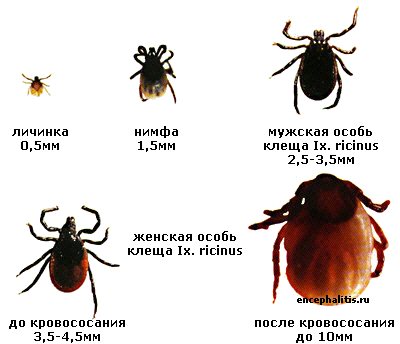

The larvae attack small forest animals and birds, sucking, they suck blood for 3-4 days, then leave their hosts and go to the forest floor. There they molt, turning into the next phase of development - nymphs, which are larger and already have four pairs of limbs.
After overwintering, the nymphs similarly go hunting, but choose larger prey for themselves: squirrels, chipmunks, hares, hedgehogs. A nymph that has been fed turns into either a female or a male after a year.
Thus, the developmental cycle of a tick lasts at least three years, and can drag on for four to five years. During this time, ticks feed only three times, while out of thousands of larvae, only a few dozen adults learn, the rest cannot survive.
For humans, only adult females and males are dangerous, while larvae and nymphs do not pose a threat.
How to fight ticks
Previously, dust (DDT) was used to kill ticks. They simply pollinated with dust from an airplane, but then they thought that it disfigures nature, since the dust decomposes poorly and accumulates in plants and organisms. They also write that if dust enters the human body, then it causes detrimental effects on human health. Therefore, about 40 years ago, its use was banned in most countries of the world. Although in my childhood they often used dust soap, they even washed their heads with them so that lice would not start.
How to protect yourself from a tick attack:
- Before going to the forest, tuck your trousers into your socks, put on tight clothes. It is desirable that the bottom of the trousers and sleeves are with an elastic band. The tick cannot bite through the clothes.
- After returning from the forest, carefully inspect the clothes and hang them out to ventilate in a non-residential area. Be sure to examine your body and take a shower.
- A popular way of protecting against ticks is garlic in the pockets of clothes, its smell does not like ixodid ticks.
- A repellent helps well, they need to spray their shoes and pants up to about the knees. But repellents fade away quickly, their effect is destroyed in a natural way.
- Currently, vaccination is considered the most effective protection against encephalitis, but it does not protect against a tick bite. An injection of immunoglobulin prevents you from contracting encephalitis, but it does not protect you from borreliosis. In addition, vaccinations kill natural immunity.
“Ticks is a highly profitable business project. The more often tick bites occur, the more money insurers, physicians, manufacturers of medicines and vaccines, pharmacists, manufacturers of protective equipment, and so on will have ”- this opinion can often be heard, and I agree with him. Not all those bitten by infected ticks get sick, I was also bitten, and I just pulled them out using the methods described above.
Why are there more and more ticks?
It turns out it's not about ticks at all. They themselves are harmless enough. They were slandered.Ticks are carriers of infection, they are victims, not criminals. They are infected by small forest animals. If our country is finally enslaved by ticks, the number of cases may not increase, but even decrease. But if mice or hedgehogs are enslaved, epidemics are inevitable. In recent years, not more ticks, but ... mice. There are many reasons for this. For example, the amount of household waste in parks and forest areas that attracts small rodents. Climate change - the warmer the winter, the higher the likelihood that ticks and small animals overwinter well. Logically, after the frost that tormented us this winter, there should be less of both. But if you ask a doctor from a vaccination center or an insurer, or a representative of a pharmaceutical company about the "tick-borne" situation, they will certainly answer you with horror in your eyes: there are more and more ticks every year, MORE!
What are the forms of encephalitis. Symptoms of a febrile form


If, for example, two people become infected with tick-borne encephalitis together, then even their symptoms may differ. Of course, the general symptoms of the virus are the same as for all infections of this type, but further, as they say, more. In addition, animals and humans have different signs of the disease.
There are the following forms of encephalitis:
- Feverish (lightest)
- Meningeal (the most common, slightly more severe than febrile);
- Meningoencephalitic (moderate or severe, not very common)
- Poliomyelitis (severe, even rarer)
- Polyradiculoneuritic (rarely seen).
In general, the symptoms are also different on how strong the immune system is, as well as on the amount of the virus introduced into the body.
The incubation period is 7 to 14 days. The first symptoms of encephalitis, inherent in any viral infection, appear after 2-4 days if the body is weakened, and after 7-10 days if the immune system is normal.
Symptoms of any of the forms manifest themselves as follows:
- Fever and temperature from 38 to 40 degrees (possible duration from 5 to 10 days);
- Headache;
- Weakness, lethargy;
- The body aches;
- Vomiting and nausea.
The febrile form acts as follows: the above signs appear, and if after 5-10 days the disease ends with a fever, then the person can fully recover and get a stable immunity to the disease. Sometimes it happens that the febrile form develops into a chronic one. This form implies that a person will occasionally experience increased symptoms of NA lesion. But if everything ended at this stage, it means that the disease has not passed into the breeding season.
There is such a dangerous moment here: the febrile form can go to the next stage, but at the same time an improvement in the person's condition will be observed. This is the so-called remission. But it's not that simple. Improvement usually lasts 7-10 days, after which the virus penetrates the brain barrier, affecting the nervous system and passing into one of the forms - most often meningeal. At this stage, the internal organs are damaged - this is the period of reproduction. In this case, the flow of the form will be easier than if it would have flowed in its original form. In this case, the febrile stage is a kind of "vaccine".
What are the signs of poliomyelitis and polyradiculoneuritic forms


The poliomyelitis form is one that presupposes a severe course of the disease and often leads to further disability in case of recovery. Rare. A severe form that ends in either death or disability of a person.
Between the incubation period and the disease itself, 1-2 days pass. At this time, lethargy, severe fatigue, muscle pain, especially in the shoulder area, appear. After that, headaches, impaired consciousness (depending on the focus of brain inflammation), vomiting and nausea, incomplete and complete paralysis in the muscles of the neck and spine, as well as the arms, occur. The patient is in a fever.All this can last up to 2 weeks of a viral illness. Further, by the end of 2-3 weeks, the muscles atrophy. You can often observe the following picture: the arms hang down, the head is turned on the sternum. The person becomes disabled.
When encephalitis develops in a polyradiculoneurotic form, this implies that painful dystrophic changes occur in the nervous system (it also depends on the focus of inflammation). A person has lethargy in the arms and legs, it is felt as if "goosebumps" are creeping over the body. Most of all, the pain manifests itself in the groin. Further, numbness of the legs, hips, and later of the arms occurs.
This form is the rarest.
Reproduction
The breeding season for ticks begins in early spring (April-May), as soon as the air temperature reaches above zero. Fertilization of the female can take place both on the owner and on the ground. After fertilization of several individuals at once, the male dies. The female, having fed enough, falls to the ground, looks for a secluded place under the leaves or in the soil crevices and, after 6-40 days, lays eggs. The number of eggs reaches 2000-3000 pieces. After oviposition, the female dies.


An interesting fact is that the continuation of the genus can take place without the participation of a male individual, in this case, all offspring will be female. Thanks to this fact, the tick population not only does not die out, but increases every year.
Important! The high risk of a tick attack occurs during the period of activity and reproduction - in May-June, as well as in August-September, in warm weather
Encephalitis infection statistics in Russia
In 2020, 32 people died from a tick bite followed by infection with encephalitis (according to Rospotrebnadzor). In 2020, 510,000 people received medical assistance who were bitten by ticks. This figure is higher than last year and generally exceeds the average annual values.
Every year from 2010 to 2020, between 29 and 50 deaths from viral tick-borne encephalitis were recorded. For 2020, 29 deaths were recorded, among them there was one child.


The main causes of complications and death from encephalitis are neglect of vaccinations and untimely visits to a doctor. The areas of sanitization are increasing every year, but the number of victims does not decrease.
In the Moscow region from 2020 to 2020, 41 cases of tick-borne encephalitis were detected, all of them certified by the laboratory. 14 cases were immediately registered when the virus was accidentally brought from other regions of Russia. As statistics show, mostly vacationers catch the infection, leaving to rest in the area in nature. Since 2003, cases of a local nature have also been recorded; for 2015-2017, this figure reached 113 registered cases out of 2873 available. In 2020, the percentage of those infected with encephalitis, namely 62%, fell on the capital of the Russian Federation - Moscow and the region.
According to data for all the past years, a greater number of infected people were noted in the Republic of Tyva. The table shows the statistics with the highest rates.
| Locality of the Russian Federation | % per 100 thousand population |
| Tyva Republic | 23,5 |
| Vologda | 23,04 |
| The Republic of Khakassia | 12,8 |
| Kirov region | 15,07 |
| Sverdlovsk region | 12,2 |
How to treat encephalitis
Treatment of sick people and animals is somewhat different.
In order for an infected person or child to recover from a viral disease, he needs a hospital under the supervision of a qualified specialist. Complex therapy boils down to:
- Strict bed rest for the entire duration of treatment;
- Antiviral medicine - the introduction in the early days of the disease of gamma globulin, designed to fight the encephalitis virus. Later, this substance is produced as antibodies in the body of the infected person;
- Prescribing vitamins c and group b in the meningeal form;
- Treatment of symptoms, especially with poisoning of the body and manifestations of damage to the nervous system;
- Application as a method of restoring anabolic steroids, tranquilizers.
Therapy for children implies the same course of healing, but, in addition, the elimination of toxins from the body is also added, and in this case, doctors are fighting not with symptoms, but with illness (in adults, the body fights poisons, as a rule, by itself), but, besides In addition, dehydration of the body is carried out. Treatment is also carried out in the infectious diseases hospital. Moreover, in children, this is a rule that must be followed strictly, since the child's immunity is not ready for such a load and without proper supervision, a lethal outcome is likely.
Animals, as already noted, are immune to this virus, which means that they are less likely to become infected with it. You need to be careful with dogs, as well as with milk-giving goats, cows and sheep.
As for dogs, when infected, the latter are treated only for symptoms, since experts are confident in a strong immune system in dogs. But with complications and severe forms of encephalitis, our younger brothers feel very bad, so much so that veterinarians advise to euthanize the animal.
In addition, the ixodid tick for dogs can be the causative agent of a completely different kind of disease - piroplasmosis. For people, however, such a disease is safe. Symptoms are similar to any viral infection, but at first, as a rule, they do not alarm dog owners in any way.
With feline encephalitis, the latter are fed with vitamins and saturate them with drugs that stimulate immunity, and also eliminate symptoms.
Diseases carried by encephalitis tick
Encephalitis tick is an insect infected with the encephalitis virus. An infected tick, getting on human skin, transmits the virus. Further - the consequences that no one can predict. It all depends on the treatment and the course of the disease.
Where does the dangerous tick live? Everywhere, including the coldest and hottest continents on the globe. What does an encephalitis tick look like? From the appearance of a tick, one cannot say whether it carries an encephalitis virus or not. The answer to this question can only be given by a laboratory assistant, having conducted a study of an insect for the presence of a virus.
The man was bitten by a tick, he was taken out of the human body and sent to the laboratory. At this time, you cannot wait for the result. You need to act immediately. Is the tick infected with encephalitis or not, but preventive measures must be taken, and without delay.
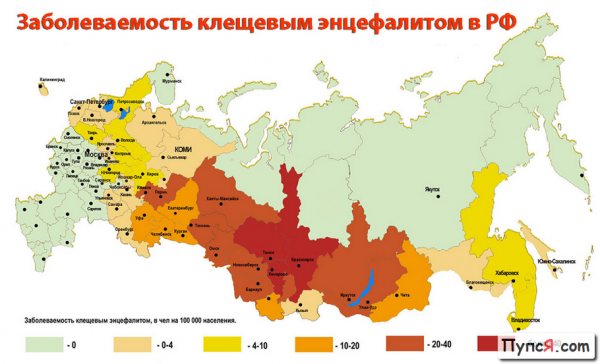

Places of activity of encephalitis ticks in Russia
How does the virus carried by the encephalitis tick into the human body develop? There are 3 options for the development of the disease.
What does an encephalitis-infected patient look like if they have the mildest form of the disease? The same as always. Everything is within acceptable limits. The encephalitis tick bites a person, then the insect is removed from the body. At the same time, no symptoms appear. Then the patient donates his blood for research. Antibodies are found in it: the body independently coped with the disease, developing encephalitis immunity.
The consequences of contact with the skin of an encephalitis tick are not always so successful.
The first symptoms of encephalitis:
- acute headache;
- photophobia;
- redness of the upper half of the body;
- dry skin;
- decreased tone of the cervical muscles;
- intoxication and fever.


Symptoms after an encephalitis tick bite
In the most severe cases, there are: epileptic seizures, confusion, hallucinations, paralysis, and this is not all that encephalitis tick is dangerous. The worst outcome, observed in 20-25% of cases, is fatal. This is considered to be a good indicator, since there are periods in which this figure rises significantly.
The situation is complicated by the fact that a layer of secondary infections is added to the activity of the virus. And all this happens because proper prevention has not been carried out. You can't put off everything related to ticks until tomorrow. The faster action is taken, the more chances of a speedy recovery. A tick with encephalitis is much more dangerous than an uninformed person might imagine.
How to provide first aid for tick-borne encephalitis


First you need to remove the sucked parasite from the body of a person or animal. You can do this yourself with tweezers or in a special medical institution. If the arachnid was removed on its own, the tick itself - if it is still alive, should be placed in a jar, and the crushed one - in a thermos with ice. This is useful for taking tests - the parasite, like no one else, will be able to help identify the diagnosis. Lubricate the wound from suction with an antiseptic (iodine, green stuff).
An important point: you do not need to lubricate the suction cup area with oil (in this case, the tick dies, but it must be delivered alive to the clinic for analysis for infection, and moreover, this complicates the process of pulling out, as a result, inflammation and purulent abscesses).
At home, an antihistamine can be given as a first aid (suprastin, claritin, erius, zirtek, telfast, etc.).
Bring the infected person to fresh air, provide him with a trip to a medical facility, taking with him a jar or container with ice where the parasitic animals are located (in case the tick was removed).
It should be borne in mind that antibiotics in the treatment of tick-borne encephalitis will not help, so it makes no sense to stuff such a medicine as a first aid. Taking an antibiotic, depending on the degree of complication, can only be prescribed by a qualified specialist. Another important point: ixodid ticks can transmit not only a virus, but also a bacterium - in this case, they speak of Lyme borreliosis. Therefore, it is extremely important to monitor the subsequent symptoms of the patient in the hospital, as well as to analyze the tick itself for signs of infection.
Further, in the medical institution, analyzes of the squeezed out tick are carried out for a sign of its infection with this virus. This is done in the laboratories of Rospotrebnadzor, in some areas, these studies can be carried out by other laboratories, the phones of which can be found on the Internet without any problems.
If a tick is seen on an animal, it is necessary to do the same, but go to the veterinary clinic accordingly.










